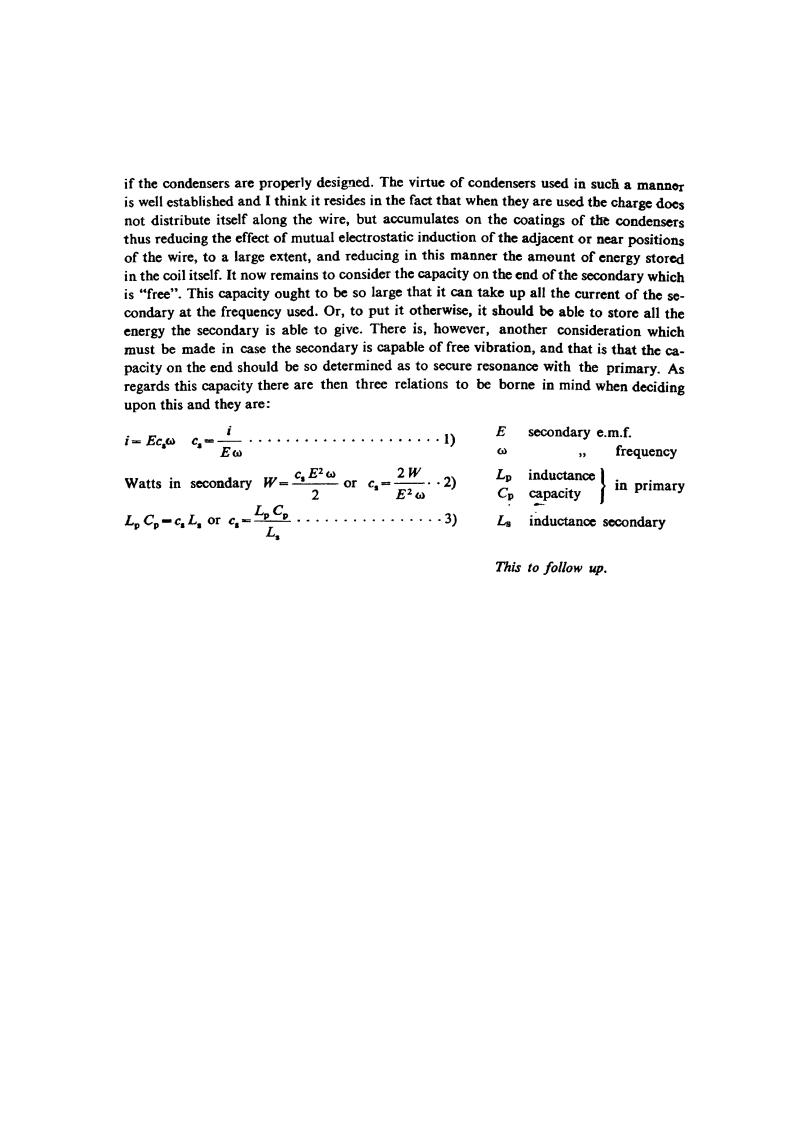
Nikola Tesla Books
if the condensers are properly designed. The virtue of condensers used in such a manner is well established and I think it resides in the fact that when they are used the charge does not distribute itself along the wire, but accumulates on the coatings of the condensers thus reducing the effect of mutual electrostatic induction of the adjacent or near positions of the wire, to a large extent, and reducing in this manner the amount of energy stored in the coil itself. It now remains to consider the capacity on the end of the secondary which is âfreeâ. This capacity ought to be so large that it can take up all the current of the secondary at the frequency used. Or, to put it otherwise, it should be able to store all the energy the secondary is able to give. There is, however, another consideration which must be made in case the secondary is capable of free vibration, and that is that the capacity on the end should be so determined as to secure resonance with the primary. As regards this capacity there are then three relations to be borne in mind when deciding upon this and they are:
| $!i=Ec_{s}Ï$! $!{c_{s}={i \over EÏ}}$! . . . . . . . . . . . . . . . . . . . . . 1) | E | secondary e.m.f. | |
| Ï | " frequency | ||
| Watts in secondary $!W = {c_{s} E^2 Ï \over 2}$! or $!{c_{s} = {2W \over E^2 Ï}}$! . . 2) | Lp | inductance | in primary |
| Cp | capacity | ||
| $!L_{p} \, C_{p} \, = \, c_{s} \, L_{s}$! or $!c_{s} \, = \, {L_{p} C_{p} \over L_{s}}$! . . . . . . . . . . . . . . . . 3) | Ls | inductance secondary | |
This to follow up.
July 31
Tesla made the capacitors for primary circuit from mineral water bottles filled with a saturated solid salt solution. He then submerged several bottles in a metal tank filled with the same solution. By that method he obtained the capacitor groups with a common layer. Other layers (electrolyte in jars) could have been connected in parallel as desired. The least capacitance change of capacitor battery of this type amounted to exactly the capacitance of one jar. By performing the withstand tests on such capacitors at a frequency of 144 Hz he concluded that they could withstand even 30,000 volts when two series of them are connected in series. By so solving the capacitor problems in primary circuit, he returns again to the secondary circuit. In the secondary he hadn't yet solved the problem of coil distributed capacitance, in which he sees the main obstacle on the way of achievement of desirable high voltages. Tesla's analysis, somewhat strange for a reader of these days (sometimes even incorrect) as hosed on a limited number of facts, impressed with its breadth. Tesla deeply penetrates in physical processes, and attempts to understand what and how something happens. His experiments provide him with proofs for conclusions he came to on the basis of thinking and analysis of previous experiments.
By having a desire to design the secondary coil with minimal self-capacitance, and which will be able to operate at extraordinary high voltages, Tesla devoted his time, more than anybody else before him, to a study of coils. The results were not lacking (coil shapes, winding methods), but with all that Tesla was not satisfied. He thinks what would happen when he would add series capacitors, and what would happen if he could change the distance between windings, or the wire diameter, etc.

